
Cygnus is a northern constellation on the plane of the Milky Way, deriving its name from the Latinized Greek word for swan. Cygnus is one of the most recognizable constellations of the northern summer and autumn, and it features a prominent asterism known as the Northern Cross. Cygnus was among the 48 constellations listed by the 2nd century astronomer Ptolemy, and it remains one of the 88 modern constellations.

Chamaeleon is a small constellation in the deep southern sky. It is named after the chameleon, a kind of lizard. It was first defined in the 16th century.

Delphinus is a small constellation in the Northern Celestial Hemisphere, close to the celestial equator. Its name is the Latin version for the Greek word for dolphin (δελφίς). It is one of the 48 constellations listed by the 2nd century astronomer Ptolemy, and remains one of the 88 modern constellations recognized by the International Astronomical Union. It is one of the smaller constellations, ranked 69th in size. Delphinus' five brightest stars form a distinctive asterism symbolizing a dolphin with four stars representing the body and one the tail. It is bordered by Vulpecula, Sagitta, Aquila, Aquarius, Equuleus and Pegasus.

A globular cluster is a spheroidal conglomeration of stars that is bound together by gravity, with a higher concentration of stars towards their centers. They can contain anywhere from tens of thousands to many millions of member stars, all orbiting in a stable, compact formation. Globular clusters are similar in form to dwarf spheroidal galaxies, and the distinction between the two is not always clear. Their name is derived from Latin globulus. Globular clusters are occasionally known simply as "globulars".
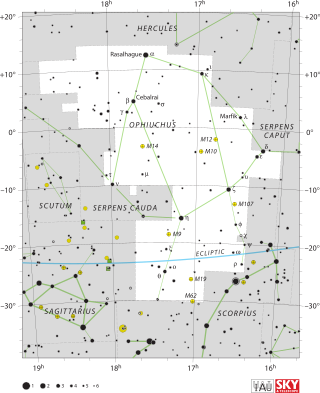
Ophiuchus is a large constellation straddling the celestial equator. Its name comes from the Ancient Greek ὀφιοῦχος (ophioûkhos), meaning "serpent-bearer", and it is commonly represented as a man grasping a snake. The serpent is represented by the constellation Serpens. Ophiuchus was one of the 48 constellations listed by the 2nd-century astronomer Ptolemy, and it remains one of the 88 modern constellations. An old alternative name for the constellation was Serpentarius.

Scorpius is a zodiac constellation located in the Southern celestial hemisphere, where it sits near the center of the Milky Way, between Libra to the west and Sagittarius to the east. Scorpius is an ancient constellation that pre-dates the Greeks; it is one of the 48 constellations identified by the Greek astronomer Ptolemy in the second century. Its old astronomical symbol is (♏︎).

Messier 4 or M4 is a globular cluster in the constellation of Scorpius. It was discovered by Philippe Loys de Chéseaux in 1745 and catalogued by Charles Messier in 1764. It was the first globular cluster in which individual stars were resolved.

The Jewel Box is an open cluster in the constellation Crux, originally discovered by Nicolas Louis de Lacaille in 1751–1752. This cluster was later named the Jewel Box by John Herschel when he described its telescopic appearance as "...a superb piece of fancy jewellery". It is easily visible to the naked eye as a hazy star some 1.0° southeast of the first-magnitude star Mimosa. This hazy star was given the Bayer star designation "Kappa Crucis", from which the cluster takes one of its common names. The modern designation Kappa Crucis has been assigned to one of the stars in the base of the A-shaped asterism of the cluster
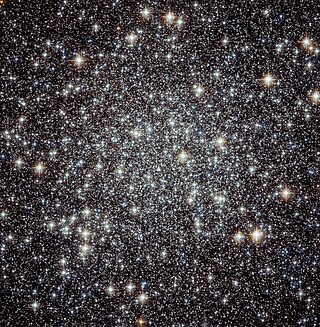
Messier 22 or M22, also known as NGC 6656 or the Great Sagittarius Cluster, is an elliptical globular cluster of stars in the constellation Sagittarius, near the Galactic bulge region. It is one of the brightest globulars visible in the night sky. The brightest stars are 11th magnitude, with hundreds of stars bright enough to resolve with an 8" telescope. It is just south of the sun's position in mid-December, and northwest of Lambda Sagittarii, the northernmost star of the "Teapot" asterism.

Messier 26, also known as NGC 6694, is an open cluster of stars in the southern constellation of Scutum. It was discovered by Charles Messier in 1764. This 8th magnitude cluster is a challenge to find in ideal skies with typical binoculars, where it can be, with any modern minimum 3-inch (76 mm) aperture device. It is south-southwest of the open cluster Messier 11 and is 14′ across. About 25 stars are visible in a telescope with a 150–200 mm (6–8 in) aperture.

The Beehive Cluster, is an open cluster in the constellation Cancer. One of the nearest open clusters to Earth, it contains a larger population of stars than other nearby bright open clusters holding around 1,000 stars. Under dark skies, the Beehive Cluster looks like a small nebulous object to the naked eye, and has been known since ancient times. Classical astronomer Ptolemy described it as a "nebulous mass in the breast of Cancer". It was among the first objects that Galileo studied with his telescope.
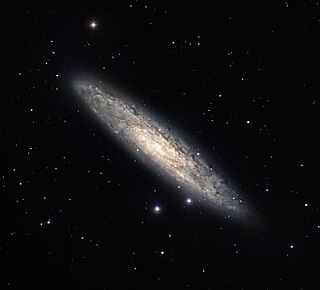
The Sculptor Galaxy is an intermediate spiral galaxy in the constellation Sculptor. The Sculptor Galaxy is a starburst galaxy, which means that it is currently undergoing a period of intense star formation.

NGC 2204 is an open cluster of stars in the Canis Major constellation. It was discovered by the German-English astronomer William Herschel on 6 February 1785. The cluster has an integrated visual magnitude of 8.6 and spans a diameter of 10.0′. Resolving the individual member stars is a challenge with a 10 to 12-inch amateur telescope. It is located at a distance of approximately 13,400 light years from the Sun. The cluster shows a mean radial velocity of +91.38±0.30 km/s relative to the Sun, and is orbiting the inner galactic disk region about 1 kpc below the galactic plane.
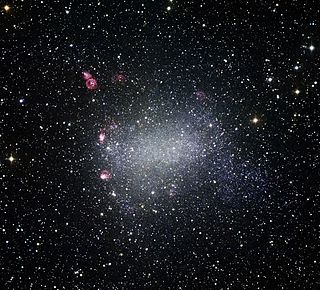
NGC 6822 is a barred irregular galaxy approximately 1.6 million light-years away in the constellation Sagittarius. Part of the Local Group of galaxies, it was discovered by E. E. Barnard in 1884, with a six-inch refractor telescope. It is the closest non-satellite galaxy to the Milky Way, but lies just outside its virial radius. It is similar in structure and composition to the Small Magellanic Cloud. It is about 7,000 light-years in diameter.

NGC 5822 is an open cluster of stars in the southern constellation of Lupus. It was discovered by English Astronomer John Herschel on July 3, 1836, and lies close to another cluster, NGC 5823, which suggests there may be a physical association.

NGC 5986 is a globular cluster of stars in the southern constellation of Lupus, located at a distance of approximately 34 kilolight-years from the Sun. It was discovered by Scottish astronomer James Dunlop on May 10, 1826. John L. E. Dreyer described it as, "a remarkable object, a globular cluster, very bright, large, round, very gradually brighter middle, stars of 13th to 15th magnitude". Its prograde–retrograde orbit through the Milky Way galaxy is considered irregular and highly eccentric. It has a mean heliocentric radial velocity of +100 km/s. The galacto-centric distance is 17 kly (5.2 kpc), which puts it in the galaxy's inner halo.
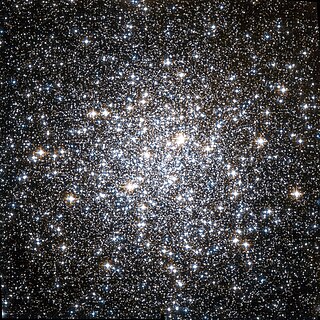
NGC 6723 is a globular cluster in the constellation Sagittarius. Its magnitude is given as between 6 and 6.8, and its diameter is between 7 and 11 arcminutes. It is a class VII cluster with stars of magnitude 14 and dimmer. It is near the border of Sagittarius and Corona Australis.

μ Ophiuchi, Latinized as Mu Ophiuchi, is a solitary, blue-white hued star in the equatorial constellation of Ophiuchus. It is visible to the naked as a faint point of light with an apparent visual magnitude of 4.62. This object is located approximately 760 light years away from the Sun based on parallax, but is drifting closer with a radial velocity of −18.5 km/s.

NGC 3256 is a peculiar galaxy formed from the collision of two separate galaxies in the constellation of Vela. NGC 3256 is located about 100 million light-years away and belongs to the Hydra–Centaurus Supercluster complex. NGC 3256 provides a nearby template for studying the properties of young star clusters in tidal tails. The system hides a double nucleus and a tangle of dust lanes in the central region. The telltale signs of the collision are two extended luminous tails swirling out from the galaxy. The tails are studded with a particularly high density of star clusters. NGC 3256 is the most luminous galaxy in the infrared spectrum located within z 0.01 from Earth.



















